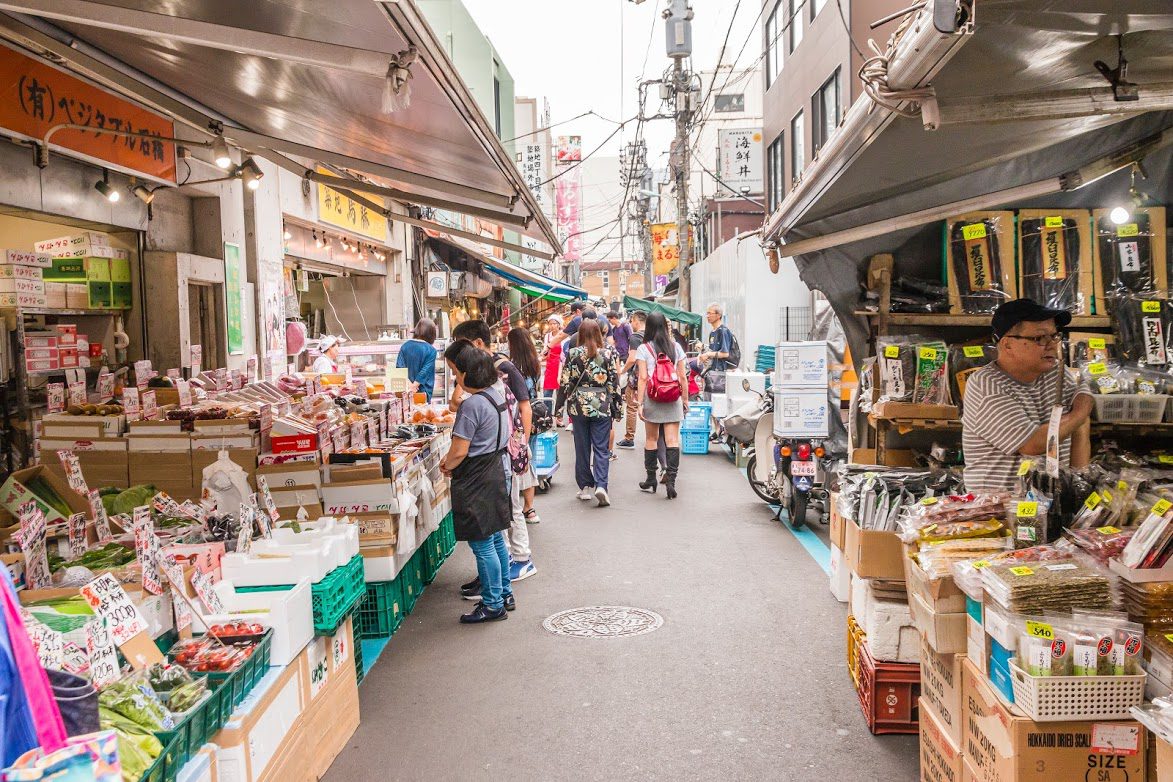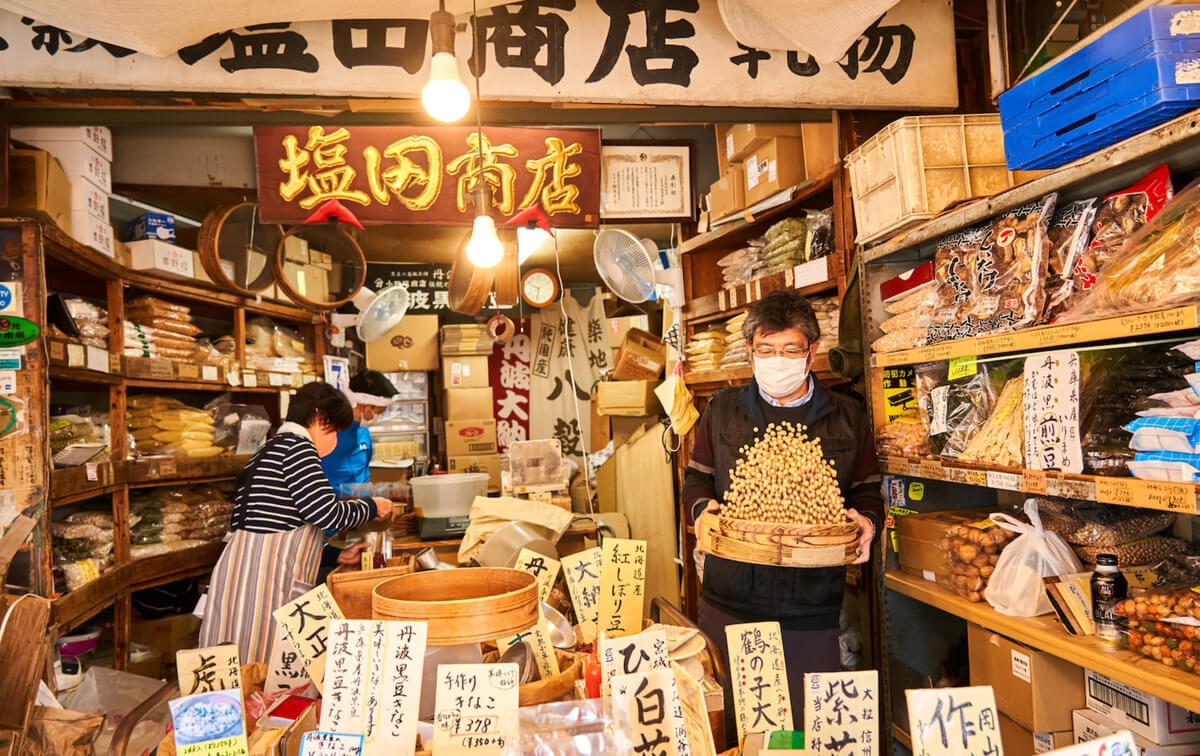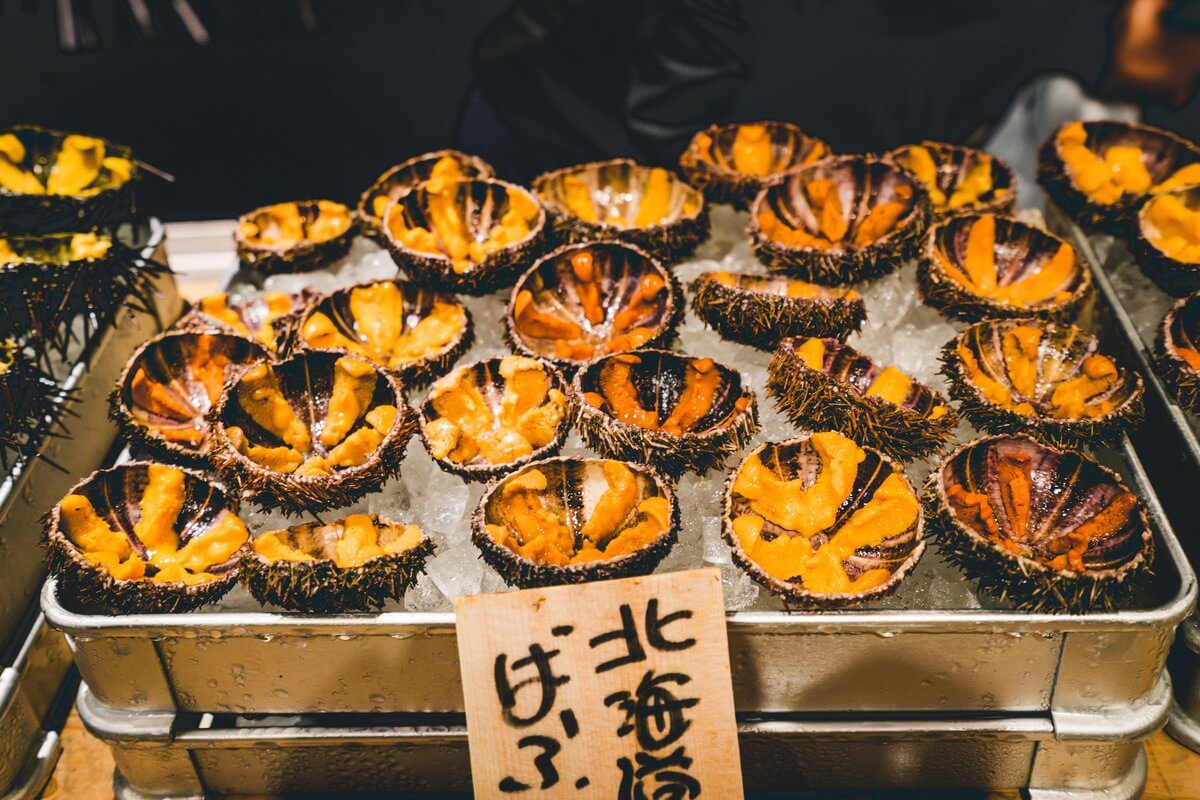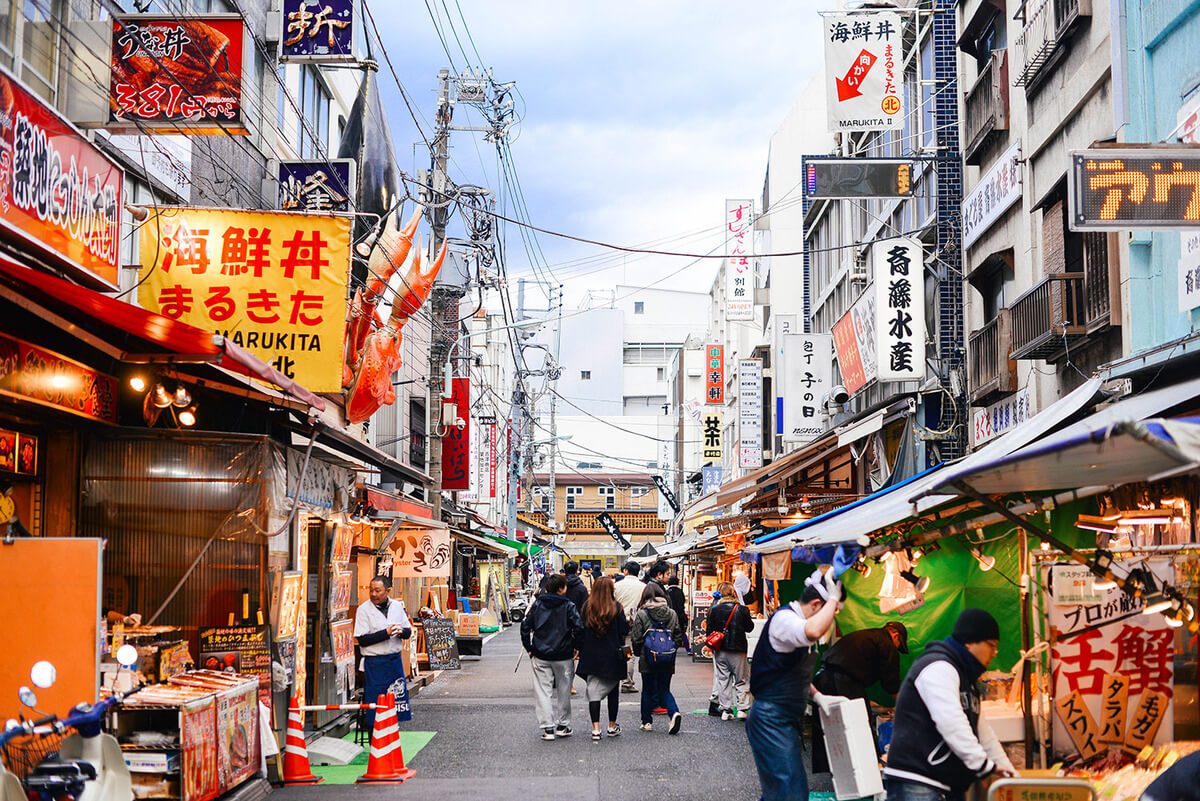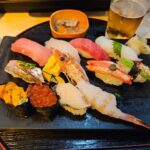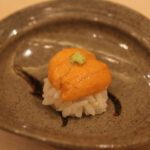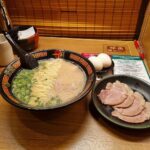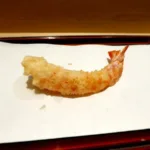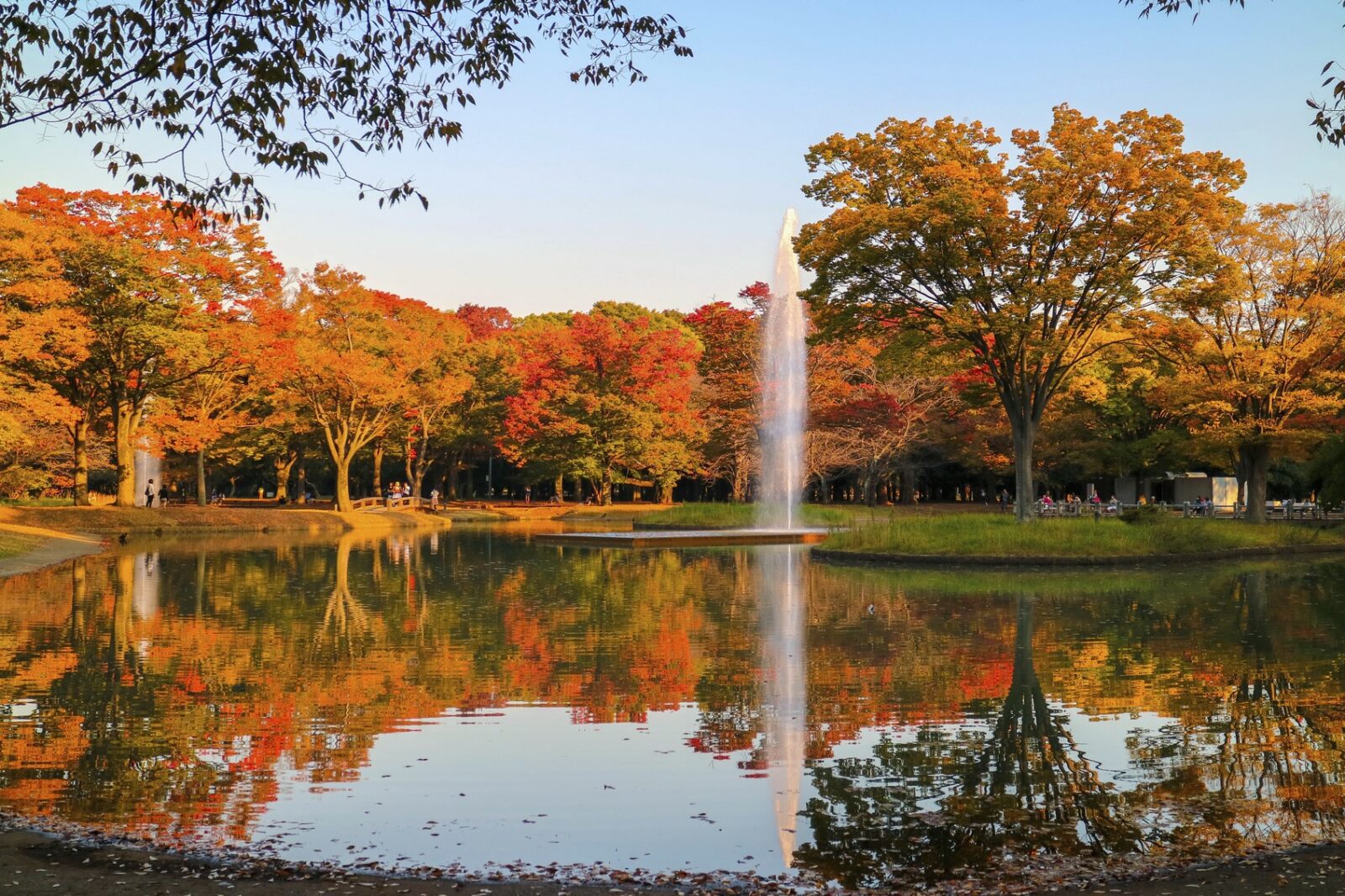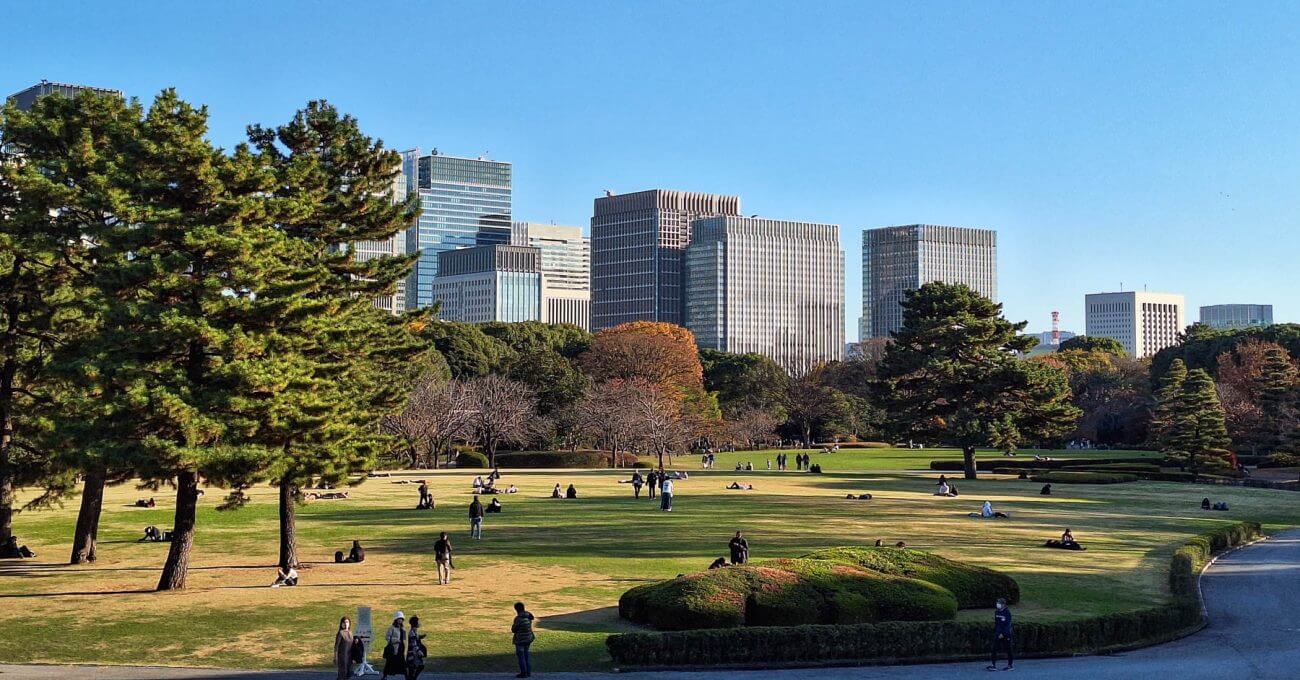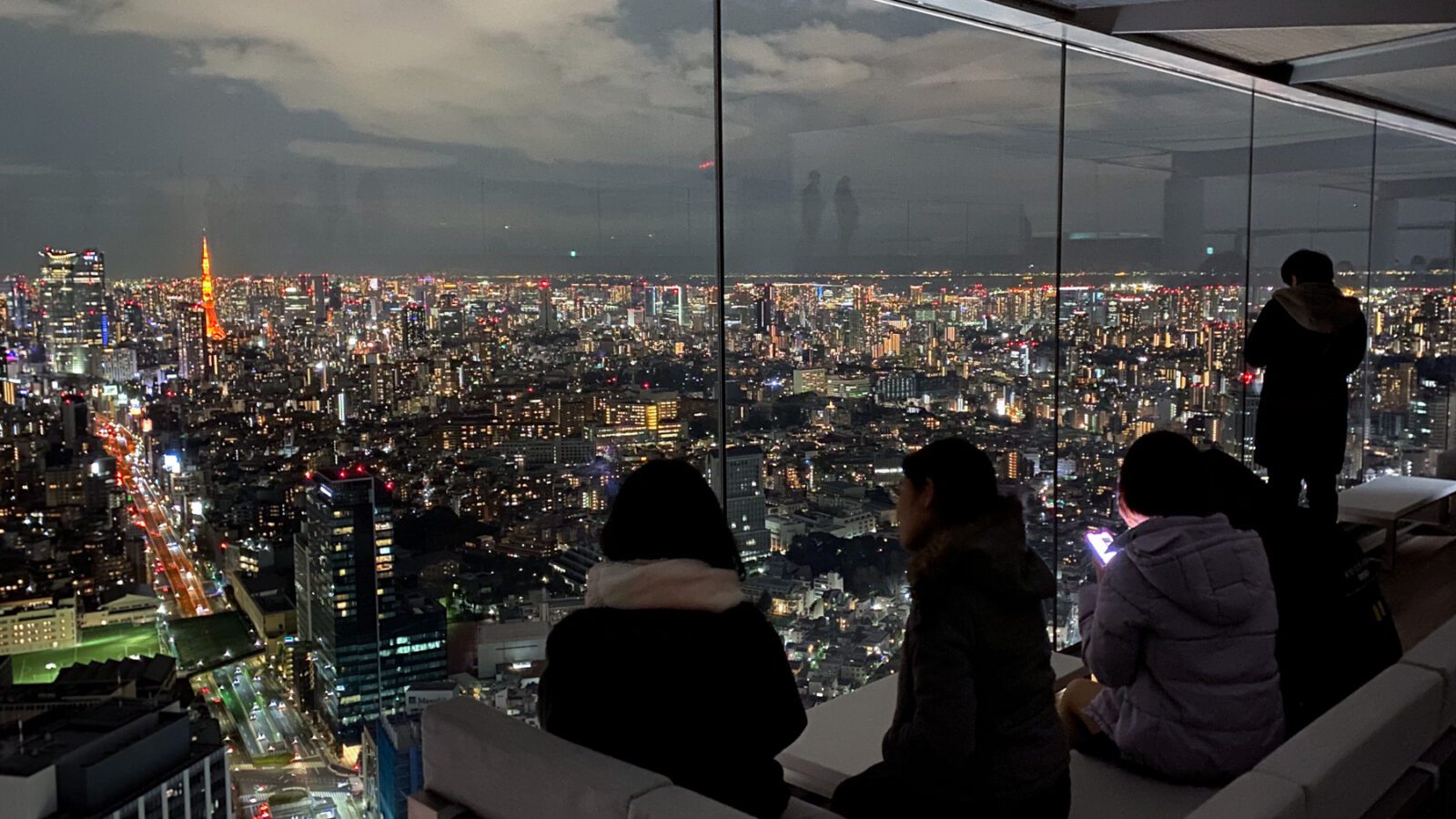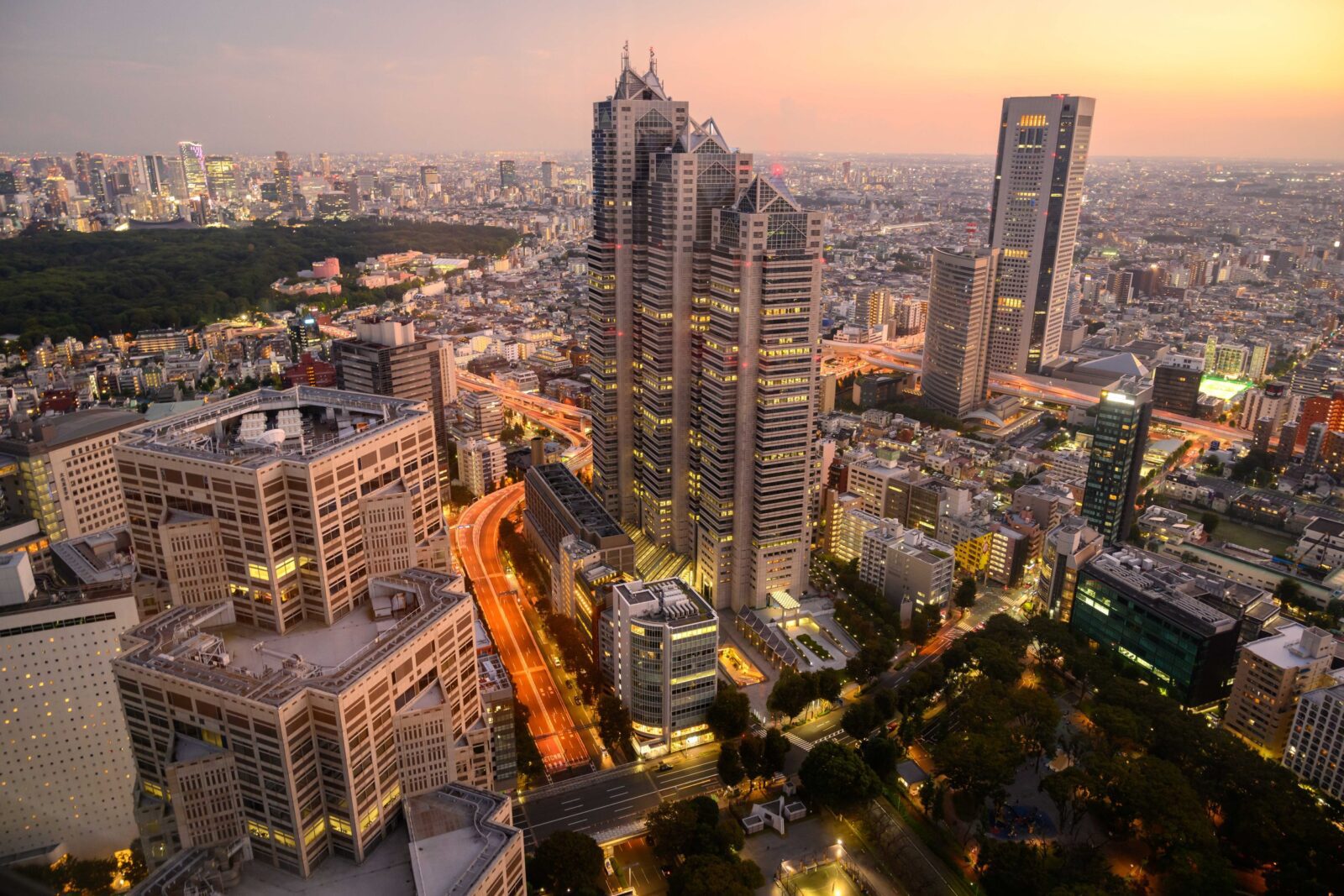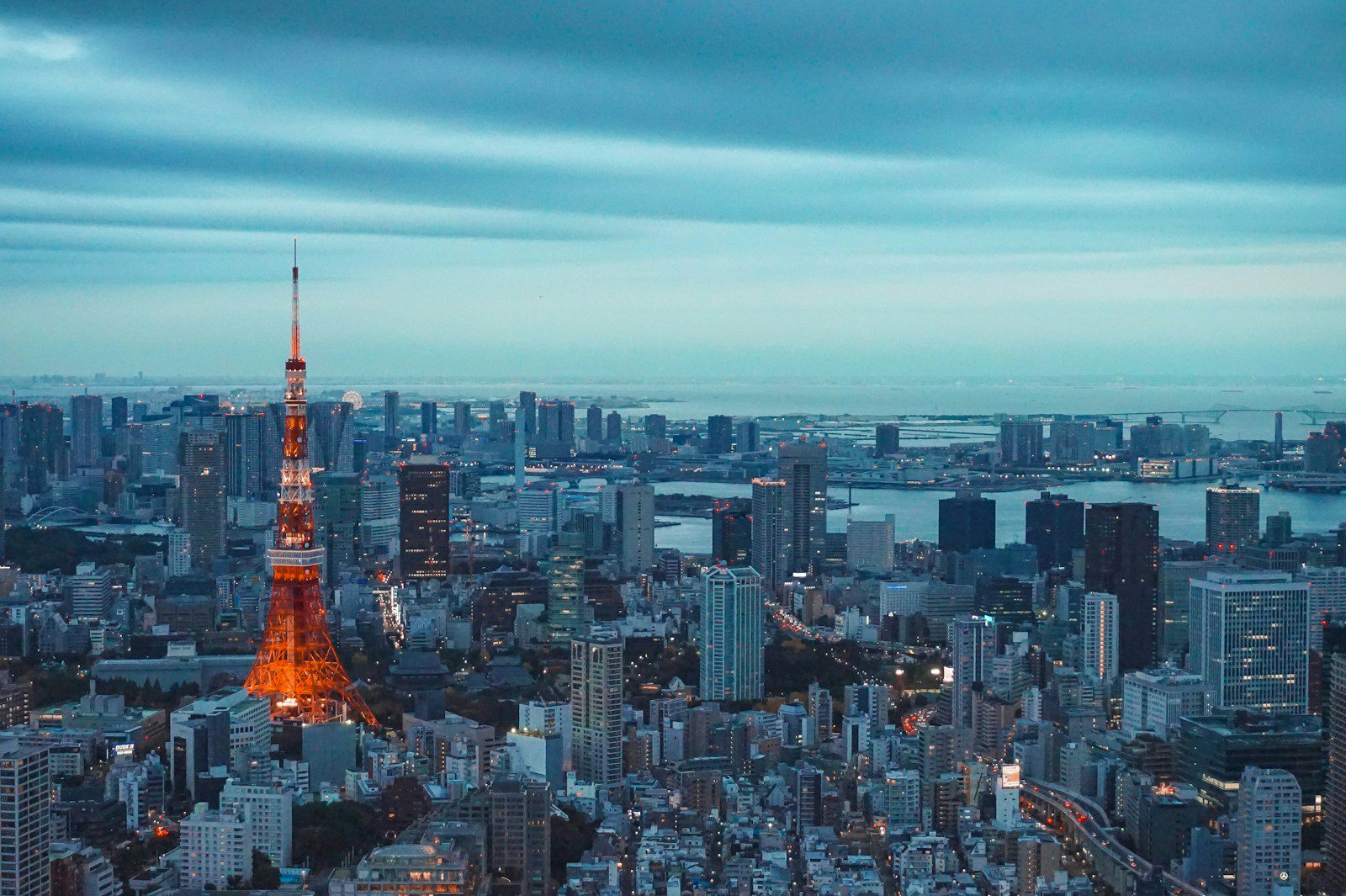Tsukiji Outer Market
Large wholesale fish market featuring a diverse selection of seafood and observation areas for a well-known tuna auction.
Overview
Tsukiji Outer Market (築地場外市場, Tsukiji Jōgai Shijō) is an area neighboring the location of the now-closed Tsukiji Wholesale Market.
The district features several blocks of wholesale and retail establishments, along with restaurants packed into tight alleyways.
Visitors can discover fresh and prepared seafood and produce, as well as culinary items like knives.
The best way to experience Tsukiji Outer Market is by pairing your visit with a fresh sushi breakfast or lunch at one of the neighborhood restaurants, which generally operate from 5:00 in the morning until around midday or early afternoon.
Since most fish served and available at Tsukiji Outer Market comes straight from Toyosu Market, this location ranks among Tokyo’s finest spots for enjoying fresh seafood.
Ultimate Tsukiji Outer Market Guide: Tokyo’s Morning Food Scene – The alarm goes off at 6:30 AM. In most cities, that would feel punishing.
At Tsukiji Outer Market, it’s your entry ticket to one of Tokyo’s most rewarding culinary adventures—a morning workout where the only reps involve raising chopsticks to your mouth and navigating narrow lanes packed with locals on a mission.
While the famous inner wholesale market relocated to Toyosu in 2018, the jogai shijo (outer market) didn’t just survive the transition—it doubled down on what it does best: feeding Tokyo’s most demanding palates while welcoming curious visitors into its chaotic, delicious fold.
What Tsukiji Outer Market Actually Is
Tsukiji Outer Market comprises approximately 400 shops and restaurants clustered along interconnected streets and covered walkways in Tokyo’s Chuo Ward.
Unlike the wholesale auctions that moved to Toyosu, this section has operated continuously since the 1930s as a retail destination where professional chefs, home cooks, and food enthusiasts source ingredients and prepared foods.
The market’s resilience speaks volumes.
Following the 2018 relocation of the inner market, predictions of Tsukiji’s demise proved wildly inaccurate.
By 2024, visitor numbers exceeded 30 million annually, while approximately 60% of transactions still involve trade customers—restaurant owners, caterers, and Tokyo residents who’ve been shopping the same stalls for decades.
This blend creates an atmosphere distinct from conventional tourist markets: genuine commerce happens alongside culinary tourism, and vendors maintain standards because their professional reputation depends on it.
The physical layout mirrors Tokyo’s organic urban development.
Narrow lanes like Namiyoke-dori and Monzeki-dori intersect at odd angles, creating a labyrinth of stalls selling grilled seafood skewers alongside century-old knife shops and tamagoyaki specialists whose recipes predate World War II.
The architecture remains determinedly unglamorous—corrugated metal roofs, weathered storefronts, hand-painted signs—which only reinforces the market’s working authenticity.
Tsukiji Outer Market: Location and Access
Here’s the details:
Getting There by Train
Tsukiji Outer Market sits conveniently between two subway stations, both offering straightforward access from major Tokyo hubs:
- Tsukiji Station (Tokyo Metro Hibiya Line): Exit 1 or 2 places travelers directly at the market’s eastern edge. The Hibiya Line connects to Roppongi, Ginza, and Ueno, making morning visits feasible from most central accommodations.
- Tsukijishijo Station (Toei Oedo Line): Exit A1 emerges near the market’s western boundary. The Oedo Line provides useful connections from Shinjuku and Roppongi.
From Tokyo Station, the journey takes roughly 15 minutes via the Marunouchi Line to Ginza, then transferring to the Hibiya Line for one stop.
From Shinjuku, budget 25-30 minutes on the Oedo Line with one transfer at Tochomae or Roppongi.
Navigating the Area
The market occupies roughly eight blocks between Harumi-dori avenue and the Sumida River.
While compact on a map, the dense concentration of shops and the constant foot traffic make navigation slower than anticipated.
The main thoroughfares—particularly Namiyoke-dori—run roughly east-west, with numerous perpendicular alleys branching off unpredictably.
First-time visitors should enter from Tsukiji Station Exit 1 and walk west along Shin-Ohashi-dori, which provides a clear orientation point.
The market lacks formal boundaries; it gradually transitions from concentrated food stalls to regular neighborhood shops as you move away from the core streets.
The Morning Rhythm at Tsukiji Outer Market
Here’s what you should do:
Timing Your Visit
Tsukiji operates on a schedule that rewards early risers while accommodating late-morning visitors with different priorities:
5:00 AM – 7:00 AM: Professional buyers dominate this window.
Several restaurants serving trade customers open their doors, offering substantial breakfast sets.
The atmosphere carries serious, transactional energy—this is working time, not browsing time.
7:00 AM – 9:00 AM: The sweet spot for visitors seeking authentic market atmosphere without extreme crowds.
Popular breakfast spots develop queues, but they move steadily.
Vendors preparing grilled items hit their stride, filling lanes with smoke from unagi (eel) and hotate (scallops).
Morning light creates excellent photography conditions in the covered walkways.
9:00 AM – 11:00 AM: Peak tourist hours arrive.
Queue times at famous establishments can exceed 60-90 minutes.
The energy shifts toward browsing and snacking rather than purposeful shopping.
Stalls selling prepared foods experience their busiest period.
11:00 AM – 2:00 PM: The market begins winding down.
Many vendors, particularly those catering to professionals, close shop.
The remaining establishments—mostly those focused on visitors—stay open, but selection narrows considerably.
After 2:00 PM: Most stalls have shuttered.
A handful of restaurants continue serving, but the market’s essential character has retreated until the next morning.
The practical implication: arriving between 7:30 AM and 8:30 AM balances accessibility with authenticity.
Early enough to experience the market’s working character, late enough that major breakfast spots are fully operational.
What Closes When
Understanding the market’s irregular schedule prevents disappointment:
- Wednesdays and Sundays: Many traditional vendors close, though tourist-oriented establishments increasingly remain open. Wednesday closures stem from the old wholesale market’s schedule; Sunday closures reflect Japan’s traditional retail patterns.
- Holiday periods: Most shops close December 31 through January 4, plus during mid-August Obon holidays. Unlike Western markets that extend hours during holidays, Tsukiji largely shuts down.
- Seasonal variations: Summer sees slightly later opening times; winter slightly earlier closures. The market responds to daylight hours and customer patterns rather than rigid schedules.
The Food: What to Eat and Where
Breakfast Sets and Fresh Seafood Bowls
Tsukiji’s reputation rests primarily on its exceptional seafood offerings, particularly breakfast rice bowls (donburi) that showcase whatever arrived freshest that morning.
Nakaya specializes in uni don—rice topped with creamy sea urchin that tastes simultaneously briny and subtly sweet.
Prices range from ¥2,000-¥4,000 depending on portion size and uni quality.
The shop occupies a tiny space with limited seating; queues form early but typically move within 30-40 minutes.
Sushi Zanmai Tsukiji operates multiple locations throughout the market.
The original shop near the Namiyoke Inari Shrine offers toro (fatty tuna) nigiri that practically dissolves on the tongue.
Morning sets start around ¥1,500 for basic combinations, scaling to ¥5,000+ for premium omakase selections.
This chain maintains consistent quality across locations, making it reliable when queues elsewhere seem prohibitive.
Kagura flies under most tourist radars despite serving outstanding seasonal fish bowls.
The smaller crowds mean shorter waits—often 15 minutes or less even during peak hours.
Their kaisen don (mixed seafood bowl) delivers variety without sacrificing quality, typically priced around ¥1,800-¥2,500.
Street Food Essentials
The market’s street food culture transforms eating into mobile entertainment.
Most vendors operate standing-room-only stalls where food gets consumed immediately or carried briefly before finding a courtyard spot to eat.
Tamagoyaki represents Tsukiji’s most iconic street food.
These sweet rolled omelets, grilled to order on rectangular pans, cost approximately ¥150-¥300 per stick depending on size and vendor.
Tsukiji Yamachō has perfected the form—their version achieves remarkable textural balance between pillowy and structured, with subtle sweetness that doesn’t overwhelm the egg’s natural richness.
Grilled scallops (hotate) appear at numerous stalls, typically sold individually for ¥500-¥800.
Vendors grill them over charcoal or gas flames, often brushing with soy-based glazes.
The quality differential between stalls is minimal—scallops this fresh need little enhancement.
Tsukiji Kitsune-ya serves grilled unagi (freshwater eel) that demonstrates why this preparation commands premium prices.
The fish gets grilled twice—first to render fat, then glazed with tare (sweet soy sauce) and finished over high heat.
A skewer costs around ¥800-¥1,200, but the smoky-sweet complexity justifies the expense.
Beyond Seafood
While fish dominates Tsukiji’s identity, other specialties merit attention:
Matcha soft-serve from several shops provides palate refreshment between savory items.
Expect to pay ¥400-¥500 for properly made versions using ceremonial-grade matcha from Uji or Shizuoka.
The slight bitterness cuts through the richness of seafood effectively.
Dashi-flavored tamagoyaki differs from the sweet street version.
Several shops sell thicker, less sweet renditions intended for home consumption, packed carefully for transport.
These cost more—typically ¥600-¥1,000 for a substantial block—but demonstrate the ingredient’s versatility.
Wagashi (traditional Japanese sweets) shops cater to locals purchasing gifts or home treats.
Tsukiji Uogashimeicha combines traditional confections with market culture, offering seasonal sweets that reflect current ingredients.
Prices range from ¥200-¥500 per piece.
Shopping for Ingredients and Kitchenware
You can also find things to shop at Tsukiji Outer Market as follows:
Japanese Knives
Tsukiji houses several renowned knife shops where professional chefs have sourced blades for generations.
Understanding the distinctions helps navigate options:
Masamoto represents the traditional apex.
Established in 1866, the shop crafts knives using techniques that predate industrialization.
Their yanagiba (sashimi knives) and deba (fish-breaking knives) start around ¥20,000 for entry-level professional models, scaling to ¥100,000+ for master-crafted pieces.
Staff speak functional English and can explain steel types, edge geometry, and maintenance requirements.
Aritsugu similarly caters to professionals while welcoming enthusiast buyers.
Their product range includes Western-style knives alongside traditional Japanese forms.
A quality gyuto (chef’s knife) suitable for home use starts around ¥15,000-¥25,000.
The shop provides complimentary initial sharpening and basic usage guidance.
Tsukiji Masamoto Sohonten (different from the main Masamoto location) occupies a smaller space but offers comparable quality with sometimes shorter wait times.
Their staff demonstrates particular patience with first-time knife buyers, explaining the practical differences between knife styles without overwhelming technical detail.
Practical considerations for knife purchases: Japanese knives typically use harder steel than Western equivalents, allowing sharper edges but requiring more careful maintenance.
Carbon steel develops patina and needs thorough drying after use.
Stainless-clad options reduce maintenance demands while retaining cutting performance.
Most shops ship internationally, though buyers should verify import regulations regarding blade length in their home country.
Specialty Ingredients
Professional-grade ingredients sold here often surpass supermarket equivalents in quality and variety:
Wasabi: Fresh wasabi rhizomes from Shizuoka and Nagano prefectures cost ¥2,000-¥4,000 per root depending on size and grade.
Unlike paste versions, fresh wasabi grated on sharkskin delivers floral complexity alongside the expected heat.
Properly stored in the refrigerator wrapped in damp paper towel, rhizomes maintain quality for 2-3 weeks.
Katsuobushi: Dried and fermented skipjack tuna, sold in hard blocks requiring specialized graters.
Ninben carries premium grades priced from ¥1,500-¥5,000 depending on processing time and fish quality.
The shop also sells pre-shaved katsuobushi and dashi packets, though purists prefer freshly shaved flakes for superior flavor.
Nori: Dried seaweed sheets range dramatically in quality.
Premium grades from Ariake Sea command ¥1,000-¥3,000 per standard pack, exhibiting deep color, crisp texture, and pronounced umami.
Mid-grade options around ¥500-¥800 serve most home applications adequately.
Practical Kitchenware
Beyond premium knives, numerous shops sell everyday tools that Japanese home cooks consider essential:
Chopsticks: Hand-carved wooden chopsticks from Wakasa region cost ¥1,500-¥5,000 per pair.
Unlike disposable versions, properly maintained wooden chopsticks last years while developing character through use.
Tsukiji Masaru stocks extensive selections including length variations and decorative options suitable for gifts.
Rice bowls and ceramics: Several shops carry practical tableware from regional pottery centers like Arita and Mashiko.
Prices range from ¥800 for basic rice bowls to ¥5,000+ for artisan pieces.
These survive international shipping better than assumed—shops pack items carefully with ample cushioning.
Graters: Copper oroshigane (graters) designed specifically for daikon, wasabi, or ginger cost ¥2,000-¥8,000 depending on size and construction.
The fine teeth create textures impossible to achieve with Western-style graters, particularly for wasabi and ginger where cellular structure affects flavor release.
Navigating the Crowds Around Tsukiji Outer Market
Here’s the the tips:
Queue Strategy
Lines form inevitably at popular establishments, but understanding queue dynamics minimizes wait times:
Most famous shops operate ticket systems during peak hours.
Arriving, receiving a numbered ticket, and returning at the appointed time works better than standing in physical queues.
This allows productive market exploration instead of static waiting.
Sushi Zanmai locations handle crowds efficiently through multiple seating areas and counter turnover that keeps lines moving.
A 30-person queue often clears within 20-25 minutes.
Lesser-known establishments serving comparable quality include Sushidai Annex and Iwasa Sushi, both maintaining high standards while attracting smaller crowds.
Arriving at these alternatives around 8:30 AM typically means immediate seating.
Walking Etiquette
The market’s narrow lanes create friction between visitor photography and vendor operations:
- Walking while eating: Generally frowned upon, particularly on the narrowest passages. Vendors prefer customers consume items near the stall or in designated open areas. This isn’t rigid prohibition—more like gentle social pressure.
- Photography: Taking photos of food stalls and general atmosphere meets no resistance. Photographing vendors’ faces or specific product arrangements without permission occasionally generates annoyance. A brief gesture asking permission usually resolves ambiguity.
- Lane positioning: Stay to the left when walking, allowing faster-moving traffic (usually local buyers with trolleys) to pass. The market’s compact spaces amplify minor positioning issues into significant bottlenecks.
Cash Requirements
Despite Tokyo’s increasing digital payment adoption, Tsukiji remains substantially cash-dependent:
Approximately 70% of market vendors accept only cash.
A small but growing minority now take IC cards (Suica, Pasmo) or QR payments (PayPay), but assuming cash-only prevents disappointment.
ATMs near the market include:
- Seven Bank ATM inside the 7-Eleven at Tsukiji 4-chome (accepts most international cards)
- Japan Post Bank ATM at Tsukiji Post Office, about 400 meters from the market core
Withdrawal limits typically cap at ¥100,000 per transaction for international cards.
Budget ¥3,000-¥5,000 per person for substantial breakfast, snacking, and small purchases.
Knife or specialty ingredient purchases require significantly more—bring ¥30,000-¥50,000 if planning major kitchenware investments.
What Tsukiji Isn’t
Managing expectations prevents disappointment and helps visitors appreciate what the market actually offers:
It’s not pristine or photogenic in a curated sense: The market evolved organically over decades.
Expect weathered surfaces, functional lighting, and aesthetics prioritizing utility over Instagram appeal.
The beauty emerges from authenticity rather than design.
It’s not undiscovered: More than 30 million annual visitors mean tourist density rivals major Tokyo attractions.
The “secret local spot” narrative evaporated years ago.
What remains genuine is the underlying commerce—locals still shop here because quality and selection justify the crowds.
It’s not comprehensive for non-food items: While kitchenware shops offer excellent selections, this isn’t a general market.
Beyond food and cooking tools, inventory thins dramatically.
Visitors seeking broader souvenir shopping should supplement with dedicated shopping districts.
It’s not cheap by absolute standards: Quality ingredients and skilled preparation command appropriate prices.
A substantial market breakfast easily reaches ¥2,000-¥3,000 per person.
Budget travelers can find cheaper options throughout Tokyo, though rarely matching this quality-price-experience combination.
Combining Tsukiji with Nearby Attractions
Hamarikyu Gardens
Located 10 minutes’ walk from Tsukiji, Hamarikyu Onshi Teien offers post-breakfast tranquility.
The traditional Japanese garden features a tidal pond connected to Tokyo Bay, tea houses serving matcha, and seasonal flowers.
Entry costs ¥300 for adults.
The garden opens at 9:00 AM, making it ideal for mid-morning visits after early market exploration.
Ginza Shopping District
Ginza’s luxury department stores and boutiques sit 15 minutes north via the Hibiya Line.
The contrast between Tsukiji’s utilitarian energy and Ginza’s polished retail environment makes for interesting cultural comparison.
Major stores include Mitsukoshi and Ginza Six, plus the Kabukiza Theatre for traditional performing arts.
Sumida River Walk
The river walkway along Tsukiji’s eastern edge provides pleasant strolling with views toward Tokyo Bay and the Sumida River mouth.
Several small parks dot the route, offering benches for resting over-stimulated stomachs.
The walk connects southward to Toyosu, though covering that distance requires genuine commitment—approximately 4-5 kilometers.
Practical Visitor Information
Here’s some practical information you’ll need:
What to Bring
- Cash: Minimum ¥5,000 per person, more if planning purchases beyond food
- Reusable bag: Many vendors no longer provide plastic bags; carrying capacity for purchases helps
- Hand sanitizer and wet wipes: Eating street food with sticky fingers while navigating crowds benefits from easy cleaning options
- Comfortable walking shoes: The market involves 60-90 minutes of standing and walking on concrete
- Light jacket (morning visits): Even summer mornings can feel cool under covered walkways; layering allows adjustment as crowds generate warmth
What to Skip
- Large backpacks: Tight spaces make maneuvering difficult; use small bags or leave large luggage at hotel
- Strict schedules: The market rewards flexible timing; rushing diminishes the experience
- Extensive breakfast beforehand: Arrive slightly hungry; eating constitutes the primary activity
- Peak weekend visits (if possible): Weekday mornings offer marginally better crowd management and more vendors
Accessibility Considerations
Tsukiji presents challenges for visitors with mobility limitations:
- Narrow lanes: Wheelchair navigation proves difficult though not impossible on main thoroughfares
- Uneven surfaces: Mix of concrete, metal plates, and occasional gaps between pavement sections
- Limited seating: Most eating occurs standing or on small stools; dedicated seating areas exist but fill quickly
- Stairs: Some shops occupy second floors accessible only by stairs
The market hasn’t modernized to contemporary accessibility standards, reflecting its historical development and space constraints.
Visitors with significant mobility concerns should research specific shops in advance and plan routes focusing on more accessible sections along Shin-Ohashi-dori.
After the Inner Market: Tsukiji’s Evolution
Understanding the market’s recent transformation adds context to the current experience:
When the wholesale fish auction moved to Toyosu in October 2018, predictions suggested Tsukiji would decline into irrelevance.
Instead, the jogai shijo adapted strategically.
Vendors who previously sold wholesale to restaurants pivoted toward retail customers and prepared foods.
Shops invested in seating areas and tourist-friendly signage while maintaining their core identity.
The transition wasn’t seamless.
Approximately 15-20% of vendors closed during 2018-2019, unable to adapt their business models.
Those remaining demonstrated remarkable resilience, maintaining quality standards that keep professional buyers returning despite the inner market’s absence.
The demographic shift proves most striking: pre-2018, roughly 70% of customers represented trade buyers; by 2024, that ratio reversed to approximately 40% trade, 60% retail/tourist.
Yet the market avoided complete tourist-ification through several factors:
Sustained professional presence: Enough restaurants continue sourcing ingredients here that vendors can’t compromise standards without losing crucial business relationships.
Family ownership: More than half the shops remain family-operated, often across three or four generations.
This ownership structure prioritizes long-term reputation over short-term tourist revenue maximization.
Physical constraints: The market’s compact layout and aging infrastructure prevent the chain-restaurant proliferation that homogenizes many tourist districts.
Space limitations favor small, specialized operations.
The Tsukiji Experience: Worth the Early Alarm?
Whether Tsukiji merits inclusion in limited Tokyo itineraries depends on individual priorities:
For food enthusiasts, particularly those interested in Japanese seafood culture, the market delivers irreplaceable experiences.
Where else can breakfast consist of sea urchin harvested 12 hours earlier, grilled eel glazed by a chef who learned the technique from his grandfather, and tamagoyaki prepared using methods unchanged since the 1940s?
For general tourists with moderate food interest, the market still offers substantial value—less for any single extraordinary moment, more for the cumulative sensory experience.
The sights, smells, energy, and organized chaos create memories that generic Tokyo experiences can’t replicate.
For visitors uncomfortable with crowds, uncertain about raw fish, or possessing limited mobility, Tsukiji’s drawbacks may outweigh its benefits.
Tokyo offers countless remarkable experiences; this particular one suits specific tastes rather than universal appeal.
The market won’t disappoint those arriving with appropriate expectations: this is working Tokyo, adapted for visitors but not manufactured for them.
Come hungry, come early, and come ready to navigate crowds in pursuit of exceptional food.
The reward isn’t just breakfast—it’s witnessing a slice of Tokyo that refuses to retire quietly, that adapts without surrendering its essential character, that feeds millions while maintaining the soul that made it legendary in the first place.
What will you order first when your alarm goes off at 6:30 AM?
Attraction Types
Related Tours
Powered by
Related Tours
Powered by
Related Tours
Powered by
Things to Know
- Wheelchair-accessible car park
- Wheelchair-accessible entrance
- Wheelchair-accessible toilet
- On-site services
- Gender-neutral toilets
- Toilet
- On-site parking
- Paid multi-storey car park
- Paid parking lot
- au PAY
- PayPay
- Transit IC cards
- dBarai
- Rakuten Pay
- V-Money
Our Notes & Verdicts
Our Rating: 4.8
We’ve visited Tsukiji Outer Market more times than we’d like to admit, and somehow, it never gets old. Each trip feels like walking into Tokyo’s open-air pantry, where you can actually connect with the people behind your breakfast. The mix of sizzling seafood, shouting vendors, and the unmistakable smell of grilled eel always pulls us in. Yes, it’s crowded, and yes, you’ll probably bump elbows, but that’s part of the magic.
What surprises us is how the market keeps evolving without losing its heart. You still meet third-generation sellers who know their tuna cuts by touch, but now they share the space with new stalls selling soy milk donuts and matcha ice cream. It’s a blend we adore—heritage meeting hustle. Our advice? Skip the checklist approach. Wander, ask questions, and eat anything that looks good. We always leave full, happy, and a little guilty for saying, “just one more bite.”
🏨 Related Accommodations
-
Dai-ichi Hotel Tokyo
1-2-6 Shimbashi, Minato, Tokyo 105-8621, Japan
-
Imperial Hotel Tokyo
1-1-1 Uchisaiwaicho Chiyoda-ku, Tokyo 100-8558, Japan
-
The Capitol Hotel Tokyu
2-10-3 Nagata-Cho, Tokyo 100-0014, Japan
-
The Prince Gallery Tokyo Kioicho, a Luxury Collection Hotel
1-2 Kioi-Cho Chiyoda-ku, Tokyo 102-8585, Japan
-
Four Seasons Hotel Tokyo at Marunouchi
1-11-1 Marunouchi, Tokyo 100-6277, Japan
Not sure which hotel to select? Try these hotel search engines below
🍽️ Related Restaurants
-
Sushizanmai Tsukijiekimae-Ten
3-11-9 Tsukiji Square bldg1F, Tsukiji, Chuo 104-0045 Tokyo Prefecture
Sushi, Healthy
-
-
Sushi Saito
1-4-5 1F Ark Hills South Tower, Roppongi, Minato 107-0052 Tokyo Prefecture
Japanese, Seafood
-
-
Operating Hours
Location
Nearest Train Station(s)
Subway: Tsukiji-Shijo Station: Exit for the Oedo Subway Line. Tsukiji Station: Exit for the Hibiya Subway Line. | JR: Shimbashi Station
Nearest Bus Stop(s)
Tsukiji-Shijo Bus Stop, Tsukiji Bus Stop, Ginza Bus Stop, Shimbashi Bus Stop
Tokyo Trip Add-Ons
Equip yourself for the ultimate Tokyo adventure with the following add-ons, curated just for you.
Frequently Asked Questions (FAQs)
The optimal arrival window is 7:30 AM to 8:30 AM for balancing crowd management with vendor availability. Earlier visits (6:00-7:00 AM) offer more authentic market atmosphere but fewer food stalls open; later arrivals (after 9:00 AM) mean longer queues at popular restaurants and more tourist density.
Approximately 70% of vendors accept only cash, though IC card and QR payment adoption is gradually increasing. Bring minimum ¥5,000 per person for breakfast and snacking, significantly more if planning kitchenware or specialty ingredient purchases. ATMs near the market accept international cards but have withdrawal limits.
Toyosu Market hosts the wholesale fish auction (relocated from Tsukiji in 2018) and primarily serves trade customers, with limited public access and observation-only visitor areas. Tsukiji Outer Market remains the retail destination with restaurants, street food stalls, and shops selling prepared foods, fresh ingredients, and kitchenware directly to consumers.
Japanese language skills aren’t required, though they enhance interactions. Popular tourist-facing establishments have English menus or photo menus, and vendors familiar with international visitors manage basic transactions effectively. More specialized shops like knife retailers typically have English-speaking staff for significant purchases.
Essential items include fresh seafood rice bowls (uni don, kaisen don), tamagoyaki (sweet rolled omelet), grilled scallops, and sushi breakfast sets. Budget ¥2,000-¥3,000 per person for a substantial market breakfast sampling multiple stalls. Arrive slightly hungry rather than fasting—the experience centers on continuous grazing.
Disclaimer
While we at Tokyo Trip Guide do our best to show you accurate prices, we just can't promise they'll stay the same. Here's why: since we're not actually selling anything ourselves - we work with partner companies who set their own prices - we can't control what deals they offer. That's why it's best to check directly with our suggested deal providers to see their latest prices for attraction tickets.
Just so you know, if you end up buying something from the providers we list here, we might get a small commission. We'd be really happy if you used our recommended links to make your bookings!

